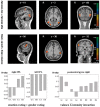Emotion unfolded by motion: a role for parietal lobe in decoding dynamic facial expressions
- PMID: 22962061
- PMCID: PMC3831559
- DOI: 10.1093/scan/nss092
Emotion unfolded by motion: a role for parietal lobe in decoding dynamic facial expressions
Abstract
Facial expressions convey important emotional and social information and are frequently applied in investigations of human affective processing. Dynamic faces may provide higher ecological validity to examine perceptual and cognitive processing of facial expressions. Higher order processing of emotional faces was addressed by varying the task and virtual face models systematically. Blood oxygenation level-dependent activation was assessed using functional magnetic resonance imaging in 20 healthy volunteers while viewing and evaluating either emotion or gender intensity of dynamic face stimuli. A general linear model analysis revealed that high valence activated a network of motion-responsive areas, indicating that visual motion areas support perceptual coding for the motion-based intensity of facial expressions. The comparison of emotion with gender discrimination task revealed increased activation of inferior parietal lobule, which highlights the involvement of parietal areas in processing of high level features of faces. Dynamic emotional stimuli may help to emphasize functions of the hypothesized 'extended' over the 'core' system for face processing.
Keywords: dynamic facial expressions; emotion perception; emotion–cognition interaction; inferior parietal lobule.
Figures



Similar articles
-
Emotions in motion: dynamic compared to static facial expressions of disgust and happiness reveal more widespread emotion-specific activations.Brain Res. 2009 Aug 11;1284:100-15. doi: 10.1016/j.brainres.2009.05.075. Epub 2009 Jun 6. Brain Res. 2009. PMID: 19501062
-
Brain networks subserving the evaluation of static and dynamic facial expressions.Cortex. 2013 Oct;49(9):2462-72. doi: 10.1016/j.cortex.2013.01.002. Epub 2013 Jan 17. Cortex. 2013. PMID: 23410736
-
Enhanced neural activity in response to dynamic facial expressions of emotion: an fMRI study.Brain Res Cogn Brain Res. 2004 Jun;20(1):81-91. doi: 10.1016/j.cogbrainres.2004.01.008. Brain Res Cogn Brain Res. 2004. PMID: 15130592 Clinical Trial.
-
Distributed and interactive brain mechanisms during emotion face perception: evidence from functional neuroimaging.Neuropsychologia. 2007 Jan 7;45(1):174-94. doi: 10.1016/j.neuropsychologia.2006.06.003. Epub 2006 Jul 18. Neuropsychologia. 2007. PMID: 16854439 Review.
-
[Processing mechanism of social cues in faces].Sheng Li Xue Bao. 2019 Feb 25;71(1):73-85. Sheng Li Xue Bao. 2019. PMID: 30778506 Review. Chinese.
Cited by
-
Dynamic Interactions between Emotion Perception and Action Preparation for Reacting to Social Threat: A Combined cTBS-fMRI Study.eNeuro. 2018 Jul 2;5(3):ENEURO.0408-17.2018. doi: 10.1523/ENEURO.0408-17.2018. eCollection 2018 May-Jun. eNeuro. 2018. PMID: 29971249 Free PMC article.
-
Brain Responses to Dynamic Facial Expressions: A Normative Meta-Analysis.Front Hum Neurosci. 2018 Jun 5;12:227. doi: 10.3389/fnhum.2018.00227. eCollection 2018. Front Hum Neurosci. 2018. PMID: 29922137 Free PMC article.
-
Effects of Intensity of Facial Expressions on Amygdalar Activation Independently of Valence.Front Hum Neurosci. 2016 Dec 20;10:646. doi: 10.3389/fnhum.2016.00646. eCollection 2016. Front Hum Neurosci. 2016. PMID: 28066216 Free PMC article.
-
Neural impact of neighborhood socioeconomic disadvantage in traumatically injured adults.Neurobiol Stress. 2021 Aug 21;15:100385. doi: 10.1016/j.ynstr.2021.100385. eCollection 2021 Nov. Neurobiol Stress. 2021. PMID: 34471656 Free PMC article.
-
Emotion Recognition Based on Weighted Fusion Strategy of Multichannel Physiological Signals.Comput Intell Neurosci. 2018 Jul 5;2018:5296523. doi: 10.1155/2018/5296523. eCollection 2018. Comput Intell Neurosci. 2018. PMID: 30073024 Free PMC article.
References
-
- Adolphs R. Recognizing emotion from facial expressions: psychological and neurological mechanisms. Behavioral and Cognitive Neuroscience Reviews. 2002;1:21–62. - PubMed
-
- Allison T, Puce A, McCarthy G. Social perception from visual cues: role of the STS region. Trends in Cognitive Sciences. 2000;4:267–78. - PubMed
-
- Bassili JN. Facial motion in the perception of faces and of emotional expression. Journal of Experimental Psychology: Human Perception and Performance. 1978;4:373–9. - PubMed
-
- Breiter HC, Etcoff NL, Whalen PJ, et al. Response and habituation of the human amygdala during visual processing of facial expression. Neuron. 1996;17:875–87. - PubMed

